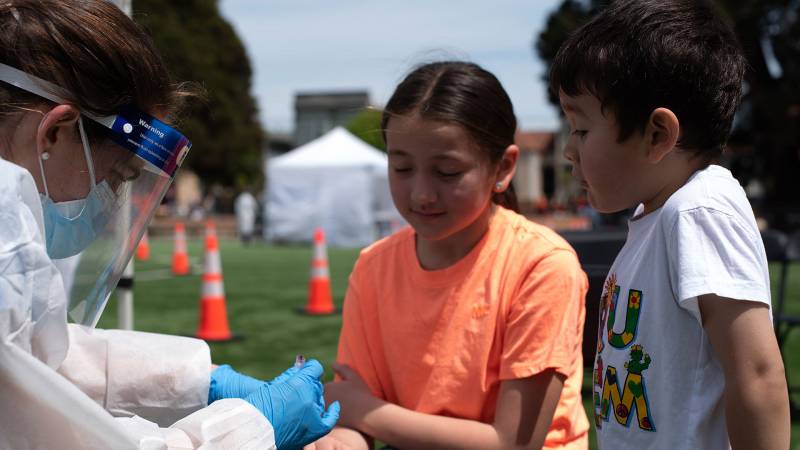As the coronavirus pandemic spreads, it’s exposing class and racial inequities across the U.S.
In California, the virus is hitting Latinos disproportionately hard. The group makes up 39% of the state’s population but 51% of confirmed cases.
The skewed numbers are even greater in the Bay Area. In San Francisco, Latinos are about 15% of the population but 40% of confirmed COVID-19 cases.
Doctors and volunteers recently tested nearly 3,000 people in San Francisco’s dense Mission District for the coronavirus. Three- quarters of the positive cases were men, and 95% were Latino.
“Zero were white,” says Jon Jacobo, chair of the Latino Task Force on COVID-19, a volunteer-run effort operating in conjunction with UCSF. “Ninety percent of those tested positive said that they did not have the ability to work from home.”
More than half of the positive cases in the Mission were asymptomatic, which means as many as 1 in 50 people living and working in the Mission could be unknowingly spreading the illness to co-workers and family members.
Can’t Afford to Shelter In Place
Two months ago Socorro Diaz stopped cleaning houses in Santa Rosa. She has adhered to the stay-at-home order religiously. But the 39-year-old mother of three can’t afford to shelter any longer.
“I honestly don’t want to work,” said Diaz. “I’m scared to catch the virus. But the bills are piling up. I have to go back to work.”
Each time Diaz leaves the house she’s haunted by what happened to her extended family in Santa Clara County, where the virus spread quickly in a cramped apartment.
A few days after her sister came home from work at an electronics factory, where mask supplies ran short, family members started coughing.
“First my sister, then her husband, then my niece, her husband, her daughter,” says Diaz. “Eventually the whole family.”
All eight family members soon lay in bed with fever, chills and body aches. COVID-19 struck Diaz’s older brother the hardest. Doctors connected him to a ventilator two weeks ago, and they expect he will be in the intensive care unit for at least another two weeks.
Underlying Health Conditions
At San Francisco General Hospital, more than 80% of hospitalized coronavirus patients are Latino, who usually make up only about 30% of the patient population in total.
“I think we’re looking primarily at a situation of high-density living conditions and people unfortunately having to be at some higher risk due to jobs, having to move outside the home and having a harder time distancing from others,” says Vivek Jain, an infectious disease specialist at the hospital.
He says many of his Latino patients struggle with underlying health conditions like obesity, asthma, hypertension and diabetes, all of which are risk factors for COVID-19.
Adriana Villatoro Ortez struggles with both asthma and diabetes. During the lockdown, she didn’t venture out of the house except to go to the grocery store. Last month, a few days after shopping for food in San Francisco’s Outer Sunset neighborhood, she started to feel sick. The 62-year-old fought nausea, body aches and a burning pain in her ribs for three days before she eventually rushed to the hospital with a high fever. X-rays and a CT scan revealed inflammation in her lungs and back.
“They gave me a slew of medication,” Ortez said. “Something to regulate my blood pressure, to settle my stomach and something to reduce pain.”
She says overwhelming nausea prevented her from eating or drinking. On the fourth day in the hospital she received a positive COVID-19 test. That same day her blood oxygen levels dropped.
“I thought the virus was going to progress, and I might not make it,” Ortez said.
After nine painful days in the hospital, doctors released her. She’s now slowly recovering at home. Ortez says her stomach still burns from taking numerous medications.
Lacking Data
In Santa Clara County, Latinos account for about 26% of the population, and 38% of confirmed cases. In Alameda County, it’s 22.5% of the population and 38% of cases. Along with San Francisco, these three counties have some of the highest numbers and rates of confirmed COVID-19 cases in the Bay Area.
Many health departments in California are not reporting racial demographic information. And when there is data, there are often a lot of unknowns. In San Francisco, Alameda and Santa Clara counties, the ethnicity is unknown for 16% to 20% of coronavirus cases.
“We need a lot more data than we’re getting,” said Dr. Richard Besser, former acting director of the Centers for Disease Control and Prevention, and the director of the Robert Wood Johnson Foundation. “And we need to ensure that in every community we’re not just getting total number of cases, and total number of hospitalizations and deaths, but we’re getting data that’s broken down by race, ethnicity, gender and disability.”
Besser says accurate numbers are necessary for draft policies that protect the most vulnerable populations. He’s urging public officials to ensure protocols are in place like Spanish health messages, masks for returning workers, and diversity among decision-makers.
“My biggest fear is that as we open up the economy, the same groups that have been devastated by this so far are going to continue to be plagued,” stresses Besser. “In America today, your income and the color of your skin are determining how you do in this epidemic and that just shouldn’t be.”
